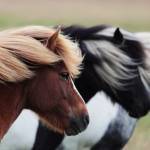Equine Gastric Ulcer Syndrome: Some Horses Don’t Follow the Rules

While no horse is completely immune from developing gastric ulcers, certain horses are more prone than others. A study specific to Icelandic horses yielded unexpected findings related to gastric ulcers, which may be a result of how this breed is uniquely managed.*
Equine gastric ulcers are divided into two types based on their location in the stomach—glandular ulcers affect the lower, glandular region of the stomach and squamous ulcers affect the upper, nonglandular region.
“Horse owners are most familiar with squamous gastric ulcers, which are typically associated with nutritional risk factors such as limited access to pasture or forage, long periods of time between feedings, and provision of large meals with high starch content,” explained Katie Young, Ph.D., a nutritionist for Kentucky Equine Nutrition.
She added, “Glandular ulcers, however, appear to be linked loosely with nutrition and management, and possibly more closely associated with exercise intensity and frequency. At this time, glandular ulcers are less well understood in horses, and research is ongoing to determine causes and effective treatments.”
Both equine squamous gastric disease (ESGD) and equine glandular gastric disease (EGGD) are clumped under the umbrella term equine gastric ulcer syndrome (EGUS), but they are different diseases with different risk factors. As such, ESGD and EGGD can occur either in isolation or together in a single horse.
Icelandic horses provide a unique opportunity to study EGUS, as they are typically managed outdoors in large herds for at least the first three years of their lives with minimal handling and supplemental forage. Once they reach three to five years old, they are brought into stalls, offered supplemental feeds, and trained.
To study EGUS in this breed, 81 Icelandic horses brought in from their early-life turnout underwent gastroscopy (“scoping”) and incidence of ESGD and EGGD was recorded. A scale of 0-4 was used for ESGD with 0 indicating no ulceration and 4 signaling severe ulceration; a scale of 0-2 was used for EGGD with 0 indicating no ulceration and 2 signaling severe ulceration. The horses then began training and were introduced to saddles and bridles. After two weeks of introductory training, structured exercise was increased gradually. The final training program consisted of three to five days of work each week totaling two hours of weekly walking, trotting, and cantering.
The initial gastroscopy found:
- Eleven of the 81 horses (14%) did not have evidence of EGUS.
- Forty percent of horses had mild ESGD, grades 1 and 2.
- Forty-five percent of horses had severe ESGD, grades 3 and 4.
- Only half of all horses (43/81) were free from EGGD.
After eight weeks of training, EGUS severity decreased. In the ESGD group, 54% of horses had no evidence of gastric ulceration, and the prevalence of severe ulceration (grades 3 and 4) decreased to 11%. The number of horses with EGGD remained stable, but the severity of ulceration decreased from 20% of horses with grade 2 EGGD to only 9%.
“A common concept in the understanding of EGUS is that pasture turnout with free access to grazing decreases the risk of disease, especially ESGD. However, these data show that a substantial number of horses had either ESGD, EGGD, or both at the start of the study when they had been on pasture for an extended period,” Young said.
There is a possibility that simply collecting the horses from pasture and transporting them to the training facility over the course of a few days could have caused EGUS.
Young explained, “More research is needed to determine whether the improved ulcer scores in stabled horses could be due to an improved or more consistent plane of nutrition from being fed individually, increased protection from environmental factors and stress, or other factors associated with unlimited or unmanaged pasture access.”
Regular feeding of forage, another management recommendation for minimizing ESGD, was supported in this study. Horses fed forage at 1.6% of their body weight during the study, offered in three meals per day, had an 18-fold reduction in ESGD score.
“Despite the fact that a relatively high number of horses had EGGD, no specific risk factors were identified to explain this finding,” explained Young. “Horses in the current study did not undergo strenuous training, were not fed rations high in starch, and other suspected risk factors of EGGD (e.g., transportation, stress due to change in management) were not found to have any effects on the EGGD status of the horses in this study.”
In sum, a surprisingly high number of horses that had been exclusively turned out on pasture in large social groups were diagnosed with ESGD and EGGD. More research is needed to understand the contributing factors in the development of both ESGD and EGGD, and the roles of forage availability and management, dietary constraints, and other potential management options in the maintenance of gastric health in horses.
If horses are subject to some of the known risk factors for EGUS, particularly ESGD, consider supporting gastrointestinal health with research-proven supplements.
*Luthersson, N., Ú.Ý. Þorgrímsdóttir, P.A. Harris, T. Parkins, and E.D. Bennett. 2022. Effect of moving from being extensively managed out in pasture into training on the incidence of equine gastric ulcer syndrome in Icelandic horses. Journal of the American Veterinary Medical Association 260(S3):S102-S110.








